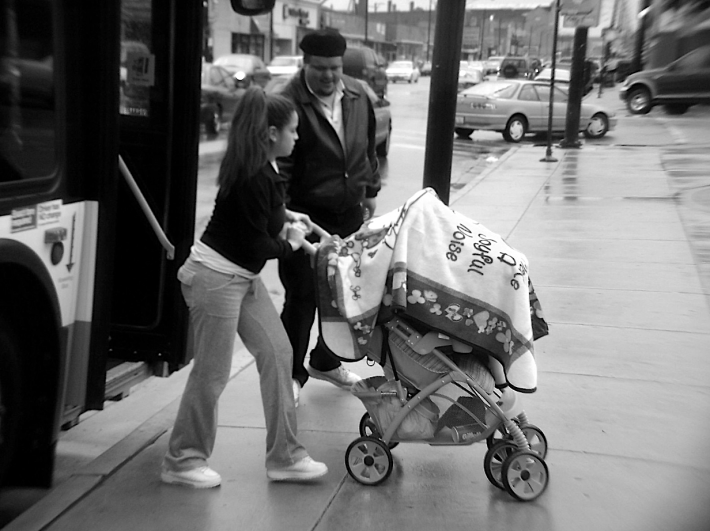
The problems that public transit riders face are exacerbated when young kids are involved. As a parent of a small child, I navigated the notoriously inaccessible New York City subway system, for more than three years and the challenges were abundant. I lived in a neighborhood that had zero subway stations with elevators so I had to carry my son’s stroller up and down two flights of stairs to take the train, or else factor in additional time to ride a bus to an accessible station when it already took me an hour to get anywhere.
Riding the bus came with its own share of issues. The MTA doesn’t allow open strollers on buses under any circumstances. Thankfully, through the city’s Early Intervention program my son Stanley -- who has several developmental delays, including the inability to walk on his own -- received a wheelchair stroller, which allowed him to safely ride the bus in his open stroller while strapped into the disabled area. Unfortunately, I got a lot of pushback for this from bus drivers and the other passengers.

Nearly every time I boarded a bus, I had to explain that the stroller was a wheelchair, and frequently the driver didn’t believe me. Passengers would often mumble under their breaths or outright say, “You should fold your stroller,” or “That’s not a wheelchair,” or something worse. One time a bus driver refused to let me on unless I folded the stroller, but I boarded anyway and received a string of insults from the driver and other passengers as a result. After that unpleasant incident, I experienced a great deal of anxiety every time I rode the bus. Perhaps if the MTA had an open stroller policy, I wouldn’t have received such a ridiculous amount of negative reactions.
Now that I live in the Chicago area, I’m happy to know that the CTA allows open strollers on buses as long as they aren’t blocking aisles or doorways. They can also be parked in the priority seating area if it’s not being used by a disabled or elderly person, but the seats must be yielded if someone with mobility issues boards. During rush hours, parents may be asked to fold the stroller or wait for a less-crowded vehicle. While that's not ideal, at least the CTA is making an effort to ensure that parents with small children can travel safely via public transportation.
A CTA spokesperson said via email that the agency “continually looks for ways to improve our customers’ transit experience. With that goal in mind, in January 2003, CTA implemented a pilot program that allowed for open strollers on our bus and rail system. CTA experienced very few problems during the two-year pilot, and customers who rode the system with open strollers expressed an appreciation for being allowed to do so. CTA permanently adopted its open stroller policy in 2005.”
Despite this policy being in effect for 14 years, local parents say they've still faced major barriers using public transportation with small children in tow. Some mothers have been forced to remove their sleeping babies from strollers, remove belongings from the bottom, fold the stroller with one hand and drag everything onto the bus when it probably would have been safer and less time-consuming for them to board the bus with the stroller open.
“Taking a sleeping baby out of a stroller is a nightmare for everyone on the bus, especially when you have stuff on the bottom,” says Emily Ann Taylor, who rode public transportation with her children from 2014 to 2017. “The CTA could offer some guidance rather than just make every new mom have to go through that.” Other parents use easily foldable umbrella strollers, but if your baby is only a few months old or you need to carry additional items, such as a diaper bag and groceries, these strollers aren’t very practical.
While some Chicago-area parents have experienced resistance when trying to board a bus with a stroller, others said they had no problem at all. “I rode the bus almost daily with an infant in a front carrier and a toddler in a stroller,” says Rachel Scheu. “I was treated according to the policy. Only a few times was I told to wait for a less crowded bus, which sucked, but it was mostly fine. Thank goodness the non-ambulatory phase was short.”

The key to ensuring that parents and their children can use public transportation safely is making sure all CTA employees are aware of the policy and know what types of circumstances require their discretion. “Training on accessibility and priority seating--including CTA’s stroller policy--is incorporated in CTA’s bus operator training program,” said the CTA spokesperson. “Operators are reminded, via re-issued bulletins, of the stroller policy and any adjustments, due to special events and high-traffic ridership.”
Of course, this training sometimes slips through the cracks. Heather, a mother in Lincoln Square, was denied entry by three consecutive bus drivers whose vehicles were empty. “We have a Bugaboo Cameleon, which never was a problem for two years, but now suddenly we can't take the bus depending on what mood the drivers are in,” she says. “It's a big gamble.”
Kyle Whitehead, spokesperson for the Active Transportation Alliance, says he believes “the policy works reasonably well and allows CTA to fairly accommodate people with disabilities and families with strollers.” However, he adds that there’s always room for improvement. “With future bus purchases, CTA could consider options with more flexible seating to ensure there’s enough space to accommodate people with disabilities and families with strollers.”





